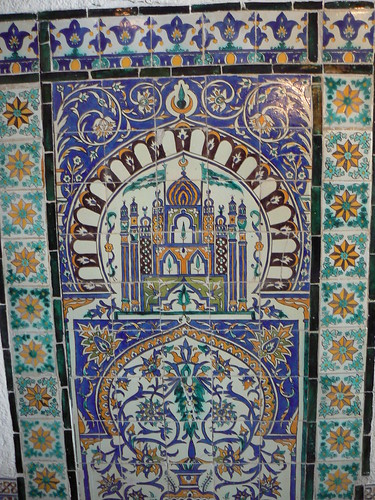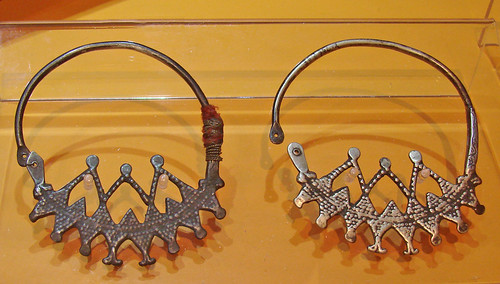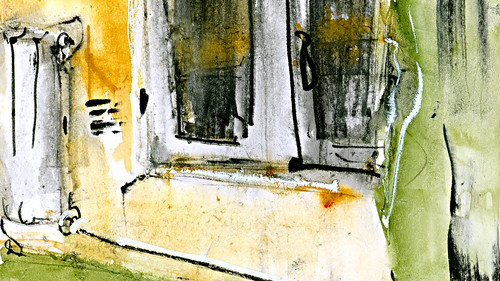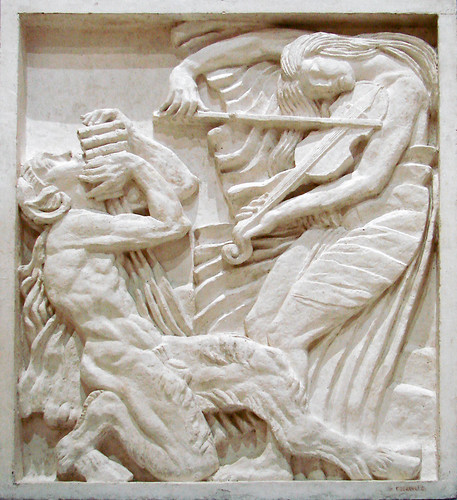Pratiques culturelles de la région des Aurès

Selon plusieurs historiens, les poteries des Aurès apparaissent dans les spécificités plastiques de leur décor incisé et de leurs formes carénées, comme les plus proches des premières formes de l'art berbère.

Origines
« Comme malgré la colonisation romaine de Lambèse, les berbères Chaouïa sont restés à l'écart des grands courants » extérieurs, « on peut admettre que cette ornementation en relief (dentelures, bourrelets, bosses, etc.) est caractéristique de la poterie berbère véritable, disons primitive. », écrit ainsi Arnold van Gennep. Analysant ce décor en relief, Gabriel Camps observe que « seule la poterie aurassienne se distingue, entre autres éléments, par la multiplication des mamelons coniques sur la panse et sur les anses, décoration qui contribue grandement à son aspect archaïque ». Lui supposant « une origine siculo-italique », il pense que ce décor, s'étant répandu au Chalcolithique sur toute une région s'étendant des côtés de la Tunisie jusqu'à l'Aurès, puis ayant progressivement disparu devant la progression de la poterie peinte, « se serait maintenu dans le bastion aurassien ».
Caractéristiques
Décorées de reliefs ou d'incisions, les poteries des Aurès sont enduites d'une laque rouge sombre ou brune, le « louq », fait de résines « cuites, triturées, teintées et modelées en bâtons qui durcissent en refroidissant », passé sur les poteries encore chaudes en fin de cuisson. Cette pratique est à la fois ornementale et, imperméabilisant les poteries, utilitaire. Le « tarbout », assiette ou plat, et la tasse au profil caréné sont souvent ornés de dessins de valeur symbolique.

Le « tarbout » présente un profil original, l'arrondi de son bord, sans méplat, s'inclinant légèrement vers l'extérieur en quatre points opposés, souvent soulignés d'encoches27. Celles-ci se retrouvent sur l'arête des tasses ou des pots à traire.
Le « fân », utilisé pour cuire la galette, n'est pas verni mais orné de reliefs ponctués de lignes et de ronds rouges.
D'autres poteries, ayant peut-être fonction de jouets, sont modelées en formes d'animaux (notamment oiseaux).
Tissage
Tissage des Aurès, région de Ghoufi (vers 1970)
La technique du tapis haute-laine n'étant pas locale, ce sont les tissages, les « tellis », les couvertures, coussins et musettes à grains qui sont caractéristiques du style des Aurès. A la laine est souvent mélangée le poil de chèvre.
Les « tellis » sont généralement composés de bandes de couleurs, mais il arrive qu'il soient ornés d'un liseré ou de quelques lignes cuivrées. De larges registres sombres, sur lesquels un décor semble brodé, coupent parfois le fond constitué de bandes unies. Des médaillons losangés, eux-mêmes composés de réseaux de fins losanges, peuvent aussi s'imbriquer sur toute la surface du « tellis ».

Les peintres orientalistes
De nombreux peintres européens et plus particulièrement français, généralement orientalistes, ont peint lors de leurs séjours dans les Aurès des paysages et des portraits, notamment Gaston Bouchinet (Castelsarasin, 1898 - Verdun-sur-Garonne, 1966), Eugène Deshayes (Alger, 1862 - Alger 1939; trois œuvres au Musée des Beaux-Arts dAlger, une au Musée d'Oran), Paul Fenasse (Alger, 1899 - New Braulnfeg, Texas, 1976), Eugène Girardet (Paris, 1853 - Paris, 1907), Louis Granata (Spezzano Grand, 1901 - Salon-de-Provence, 1964), Édouard Herzig (Neuchâtel, 1860 - Alger, 1926; deux œuvres au Musée d'Alger), Roger Irriéra (Bordeaux, 1884 - Aix-en-Provence, 1957), L. (Léonie?) Lebas, Constant Louche (Alger, 1880 - Grenoble, 1965), Fritz Müller (Blida, 1867 - Alger, 1926; une œuvre au Musée d'Alger), Maxime Noiré (Guinglange, Moselle - 1861 - Alger 1927) qui y travailla de nombreuses années et fut surnommé « le chantre des Aurès » pour ses vues dites « rosées » (quatre œuvres au Musée d'Alger), Jules Van Biesbroeck (Portici, Italie, 1873 - Bruxelles, 1965).
Les peintres algériens contemporains
Plusieurs artistes sont nés, tel Jeballah Bellakh, et vivent dans les villes des Aurès. Certains sont morts comme Abdou Tamine et Chérif Merzougui. D'autres peintres ont immigré vers l'Europe comme Houamel Abdelkhader qui vit en Italie.
Dans les Aurès, il n'y a ni galerie d'art ni musée des beaux-arts. Cependant, les maisons de la culture de Batna, de Khenchela, de Biskra, etc., organisent des activités artistiques telles que des expositions, des rencontres, etc32.
En 2007, lors du festival Alger la capitale de la culture Arabe, plusieurs activités se sont déroulées dans les régions des Aurès.

Musique
Le folklore est diversifié dans les régions des Aurès. La musique traditionnelle est bien représentée par nombreux chanteurs aurassiens. Les premiers chanteurs qui ont connu un succès international sont Aissa Jermouni et Ali Khencheli. Le style de musique Rahaba est propre à toute la région des Aurès. De plus, plusieurs styles de musique existent comme le style arabo-andalous, l'un des chanteurs chaouis Salim Hallali. Plusieurs chanteurs des Aurès se sont inspirés de ce style comme Youcef Boukhantech.
Les femmes ont pu avoir leur place sur la scène nationale. La télévision algérienne diffusait les chansons de Thelja (Ya Saleh) et de Beggar Hadda dans les années 1970. Aussi, Houria Aïchi a fait plusieurs albums en France, ainsi que la célèbre chanteuse Dihya (du nom de la reine des Aurès), épaulée de Messaoud Nedjahi, l'un des meilleurs compositeurs et paroliers Chaoui. L'un de ses meilleurs albums s'intitule Dzaier assa.
Un autre genre de musique moderne chaoui s'est imposé dans la région. Cette musique atypique est un mélange d'inspirations de rock, de blues, de folk et de raï en langue chaoui et en arabe. Quelques chanteurs et musiciens aurassien(ne)s s'illustrent dans ce genre tels que Belbeche, Katchou et Nacerdine Hora, tous ayant commencé en langue chaoui, pour ne citer qu'eux. D'autres, plus jeunes, utilisent exclusivement la langue chaoui. Ainsi le Groupe Tafert, Youba etc. Quelques instruments de musique sont propres à la région comme la Gasba, etc et d'autres telles la Zorna sont spécifiques à l'ensemble de la musique orientale (Cf en Turquie). À tort, beaucoup de gens attribuent à ce genre une appellation « Staifi » en raison du fait de l'utilisation de la langue arabe tandis que la musique, en elle-même, est chaoui.
Littérature
Plusieurs écrivains ont écrit dans les deux langues, arabe et française, c'est le cas de Kateb Yacine.
La poésie orale, les contes et les légendes font l'objet d'étude de la part des spécialistes en littérature et en linguistique.
Mohamed Hamouda Bensai (1902-1998) était essayiste et philosophe.
La grande romancière suisse Isabelle Eberhardt (1877-1904) a habité Batna dans le quartier de Zmella.
Plusieurs auteurs Batnéens ont écrit des livres comme El hachemi Saidani (mort en 2005), Mohamed Nadir Sebaa (né en 1956), Abderezzak Hellal (né en 1951), Beïda Chikhi, Docteur d’État et professeur à la Sorbonne, etc.
Plusieurs auteurs d'origine française ont écrit également des livres qui traitent des thèmes liées aux Aurès et à la ville de Batna comme Jean-Pierre Marin, Jean-Noël Pancrazi (né en 1949), Liliane Raspail, Jean Pèrés et Eugène Delessert, etc.
Claude-Pierre-Hypoplyte Polain, historien, est mort le 17 mars 1876 à Batna.
Anna Gréki (1931-1966) fut écrivaine et militante de la cause du Front de libération nationale (Algérie).
Les auteurs comme Redha Malek (né en 1931), Mustapha Bekkouche (né en 1930), Amar Mellah (né en 1938), Merarda Mostefa Bennoui, Ali Merouche ont écrit des livres documentaires et historiques.
La poésie arabe : le poète Mohamed Laïd Al-Khalifa (1904-1979), Mohamed el akhdar el Saihi, Mohamed Ababsa El Akhdari, ont écrit plusieurs poèmes sur la ville de Batna et des Aurès.
Messaoud Nedjahi a écrit plusieurs romans en langue française sur la vie des chaouis..
André Gide (1868-1951) a visité les Aurès. Il fut un ami de Mohamed Hamouda Bensai (1902-1998).
Liliane Amri (née en 1939), mariée à un Chaoui, est l'auteure du roman La Vie à tout prix. Son livre est une autobiographie et elle livre une description de la vie des Aurès, surtout des femmes pendant les années 60 à 90. Elle parle parfaitement le chaoui et elle a contribué au développement de la région des Aurès.
Germaine Tillion (1907-2008) a séjourné dans les Aurès pendant des années. Elle a fait un grand travail scientifique sur la région des Aurès. Elle a envoyé des lettres au gouvernement français pour défendre la cause des Algériens pendant la Guerre d'Algérie.
Dans son ouvrage, Mathéa Gaudry décrit la vie des femmes Chaouis, les us et coutumes de cette région en particulier dans la période coloniale de 1929. Elle trace l'historique de la Kahina.
Bachir Rahmani (1957), médecin écrivain, a écrit Amrir, (2002), dont la note de lecture faite par le quotidien l'Expression du 12-09-2002 s'intitule : « Un sacerdoce au cœur des Aurès ».
Saleh Bezzala, poète en langue chaoui.
Nassira Belloula, née à Batna et auteur de plusieurs romans, récits et essais comme La Revanche de May, Visa pour la Haine, Rebelle en toute demeure, Djemina ou encore Les Belles Algériennes.



/image%2F1307487%2F20240414%2Fob_5f1137_messenger-creation-0be6fdfe-aff8-4b46.jpeg)
/image%2F1307487%2F20240317%2Fob_4d78a4_20240316-163013.jpg)
/image%2F1307487%2F20240303%2Fob_230fb0_20240302-153118.jpg)
/https%3A%2F%2Fstorage.canalblog.com%2F25%2F72%2F1172757%2F134180966_o.jpg)



